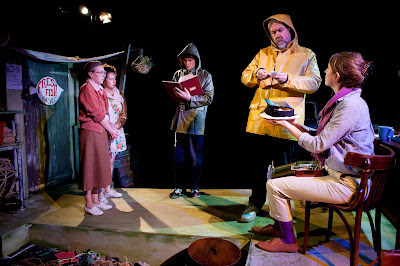UP OUT O' THE SEA
Eastern Angles at the Town Hall, Maldon
10.03.11
Off the lonely Suffolk coast, eroded by the relentless waves, a wreck has lain for thirty years. Now it is to be brought to the surface, just as a prickly journalist from London turns up in the the tight-knit local community, with her laptop and her searching questions.
That's the starting point for Andrew Holland's Up Out o' the Sea, an atmospheric piece dealing with those Eastern Angles stock-in-trade themes of origins, ghosts and time-slips.
A simple, weathered set sits across the Town Hall in Maldon, replicating the John Mills Theatre back in Ipswich. “Fresh Fish For Sale – Special Offer Herring £1.50 lb” at one end, with a suggestion of the mooring and the remote Point. At the other, the village library.
The company of five bring some pretty complex characters to life, as their stories unfold and intertwine. Rough-edged chancer Tweedie, looking for love and a way out of the dead-end, was played by Francis Woolf, who caught precisely the mixture of bravado and vulnerability. His colleague, Dolphie, the only survivor of the volunteer crew that attempted the rescue on that fatal night, was Mike Aherne, who managed to make the grumpy old fishermen both believable and sympathetic.
Lisa-Marie Hoctor played two linked characters, both immature, both young mothers; sometimes hard to grasp all her words in this less than ideal acoustic, but I loved her Emily, the mysterious girl with a touch of the devil, who dreams of passing through into glory …
Laura Harding was brilliantly convincing as the writer with secrets of her own – the picnic at the Point was movingly done, as was the “information versus emotion” dialogue with Lisa-Marie's modern Milly.
And Lisa Tramontin played the Librarian, by no means a stock character, despite her stereotype hair and cardigan. Though not all of the dialogue she was given rang true, she did provide some of the most touching moments in a play of many layers and textures. Including the key revelation, a real goosebumps realisation.
Music was powerfully used – a Bach Passion mainly – and simple but effective lighting suggested the sunshine and the showers, the night and the storm. The setting was practical and versatile - I admired the imagination that turned a door with oilskins hanging from hooks into a stretcher for the victims of the storm.
In the end, after a rescue which echoes the earlier disaster, they decide to leave the wreck where it lies – a memorial draws a line under a past event whose details are gradually revealed in this intriguing piece, directed, with his usual sure touch for the intangible, by Eastern Angles' Artistic Director Ivan Cutting.
production photograph: Mike Kwasniak
this piece first appeared on The Public Reviews

No comments:
Post a Comment
Note: only a member of this blog may post a comment.